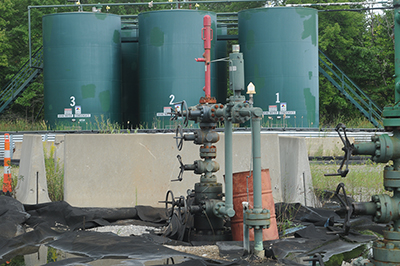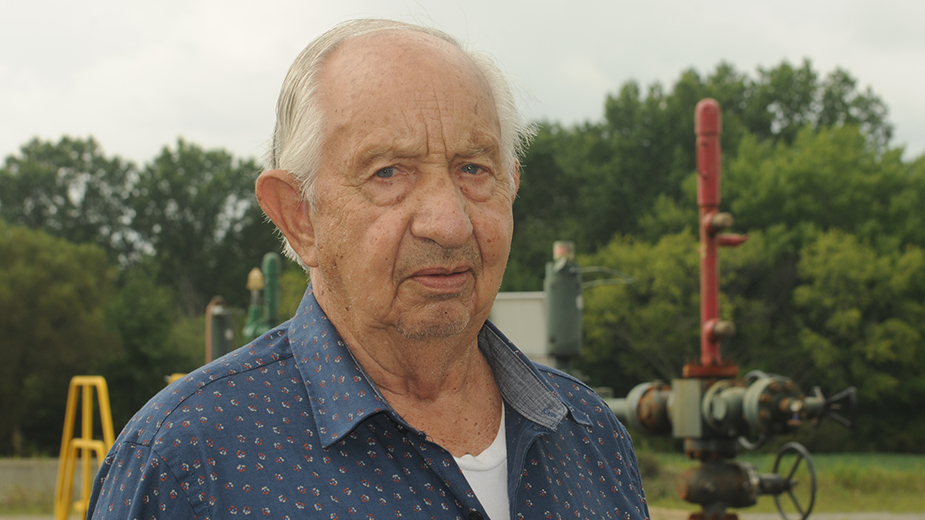First in a two-part series
NORTH JACKSON, Ohio – Mel Cadle scopes out the well pad that was constructed on his North Jackson farm nearly 10 years ago.
The site, dominated by six large, green storage tanks, is unkempt, strewn with weeds, and sits back on a 20-acre plot he owns along Blott Road.
Cadle once envisioned years of lucrative royalties streaming directly into his bank account from oil and gas pumped from the two wells drilled on his property.
Simply put, he wanted to get rich.
“It didn’t work out like it was supposed to for me,” the 87 year-old Cadle says. “I don’t have any income from these wells. I lost five acres for nothing.”
Cadle personifies a complicated legacy of the oil and gas industry 10 years after energy companies descended on eastern Ohio in search of reserves trapped in the Utica/Point Pleasant shale formation. The development of hydraulic fracturing and horizontal drilling made it possible – and profitable – for exploration companies to tap into tight shale formations 6,000 feet deep and extend laterals thousands of feet across these thin strata.
The expectations of long-standing economic benefits to the region were enormous. Energy companies touted investments in the billions of dollars for drilling programs, leasehold contracts, processors, pipelines and support services to the industry. Companies supporting the oil and gas supply chain would also relocate, augmenting further job growth in the region.
For some, drilling the Utica meant up-front lease signing bonuses between $1,000 and $6,000 an acre, and many believed the big payoff would come in the form of monthly royalty checks. Early in the play, it was estimated that landowners with a producing Utica well pad on their property could reap as much as $1,000 per acre, per month.
For many landowners, though, the promise of sustained wealth remains just that.
In Cadle’s case, complications arose because of a lease he purchased in 2008 on the 20 acres where the well pad sits. When he purchased the property, he was under the impression that all of the mineral rights were included.
However, a Mahoning County Common Pleas Court found in 2015 that the lease assignment covered the rights to just two Clinton standstone wells that operate on another 70 acres Cadle had purchased during the 1980s.
Beginning in 2012, Consol Energy drilled two Utica-Point Pleasant wells on his property. The mineral rights to those wells, however, are not part of his lease, the court found. Instead the rights to the Consol wells, now owned by Northwood Energy Corp., remain in the hands of a family trust from the previous owners.
“I was so looking forward to getting a well drilled there and then getting rich,” Cadle says. “I bent over backwards to get those wells drilled.”
Instead, the only income derived from his land today is through farming soybeans and corn.
Cadle doesn’t fault the energy companies – he’s supportive of their efforts in the region. He’s upset over how the lease he owned was interpreted, leaving him out in the cold.
“I have a piece of paper saying I own this, but they’re saying I don’t,” he says.
Other landholders across the region had hopes of steady royalty payments flowing into their pockets, only to discover just how outlandish the early proclamations were.
“It’s been nothing like I expected,” says Doyle Hawk, a farmer who has about 250 acres of his land tied to six different wells in Carroll County. “They were saying that we’d get about $1,000 a month per acre in royalties. You’re lucky if you get $20.”

Hawk says the wells near his property were initially drilled by Chesapeake Energy Corp., which led the drive among big energy producers into the Utica in 2010 and 2011. Dealing with Chesapeake was difficult, he says, arguing that the company often failed to make good on paying on its gross leases. “They never paid on the gross lease, despite the proof,” he says.
A gross lease means that an energy company pays royalties on a certain percentage of the total volume of oil or gas produced from a well. While the minimum royalty payment is about 12.5%, some landowners had negotiated rates as high as 20% as energy companies swamped eastern Ohio, locking up leasehold agreements.
In 2018, Houston-based Encino Acquisition Partners bought Chesapeake’s stake in eastern Ohio in a deal that included drilling rights to 900,000 acres and more than 900 wells. “Overall, it’s improved since Encino took over,” Hawk says. “They’ve honored the gross leases, and they’re starting to lease more ground,” he says.
Still, royalty payments aren’t even close to what was preferred a decade ago, as many wells have curtailed production, Hawk says. “Ours might be up to $35 to $40 an acre,” he says. “That’s not what they said when they came in here the first time. There are some wells around here that have completely shut down.”
Hawk says he knows of landowners who, believing they would receive a windfall in royalty money, embarked on a buying spree on equipment and other high priced goods for their farms. “Then, the checks came in. It wasn’t what they expected and they were caught off guard.”
Cynthia Koonce, a sheep farmer in Guilford Lake in Columbiana County, says that when Encino acquired the wells her property is tied into, royalty payments dropped by 75%. “There were five months out of the year when we got absolutely nothing,” she says. “It irritates me.”
Others have taken their grievances to court.
In 2015, a class action complaint on behalf of 270 landholders in Columbiana and Carroll counties was filed in U.S. District Court for the Northern District of Ohio against Chesapeake and related entities. The complaint sought monetary damages against the defendant for “systematically violating oil and gas leases and underpaying royalties.”
“Things have not turned out as to how they were presented,” says Richard Zehentbauer, co-owner of Hanover Farms in Columbiana County and a lead plaintiff in the class action complaints. “For these landowners, it’s been more of a problem than a Godsend.”
The complaint states that Chesapeake was taking improper deductions from royalty payments, thereby lessening the amounts. Last year, the court ruled in favor of the energy company. The ruling is under appeal.
Zehentbauer says what irritates him the most is that most of the profits and wealth from the Utica leave the state. “They’re taking the minerals and depleting our resources with virtually no compensation for what they’re taking,” he says. “I wish it had never come, honestly.”
Encino spokeswoman Jackie Stewart says that when the company acquired Chesapeake’s assets, it adopted a completely different approach than its predecessor, particularly when it comes to communicating with leaseholders.
“We met with land groups and we’ve implemented a policy of transparency and communication,” she says. “As a result, our complaints have dropped by 90%.”
Commodity prices collapsed in 2020 because of the worldwide pandemic, and oil and gas companies are still struggling with the aftershocks, Stewart says. At the same time, costs of operating and maintaining the wells have increased, she adds.
“2020 was difficult for us and landowners as well,” Stewart says.
Royalty payments in the Utica have tumbled because of two factors, says Alan Wenger, an oil and gas attorney at Harrington, Hoppe & Mitchell in Youngstown. First, the wells in the Utica have naturally depleted over time and simply no longer produce the volumes of five or 10 years ago. Second, lower oil and gas prices over the past several years have forced energy companies to reduce, or in some cases shut down, production from underperforming wells. The impact of the COVID-19 pandemic didn’t help.
“Royalty payments have been fairly modest,” Wenger says. “There are some excellent wells and fortunate landowners, but most are less-than-amazing royalties.”
The scope of the Utica has also narrowed over the last decade, Wenger says. Energy companies have more data to determine where the best producing wells are located, and concentrate on these “hot spots.”
For those landowners that hold leases but no wells on their property, energy companies are unlikely to offer the large up-front bonuses to renew these contracts, especially if they’re outside the lucrative production zones, Wenger says.
“They’re offering significantly less,” he says.“Some are $50 and acre.” In 2011, some bonus payments hit $6,000 an acre, he says.
Exploration activity has tapered off considerably across the Utica shale over the last 10 years, especially in the Mahoning Valley. Not a single new permit has been issued in Trumbull or Mahoning County since 2013.
Columbiana County remains the most active area in the Mahoning Valley region for oil and gas exploration. Since the beginning of this year, 16 permits have been issued for new horizontal wells in the county, 15 of which were awarded to Houston-based Hilcorp Energy Co. A single permit was issued to Encino.
“We drilled our first well in Columbiana County this year,” says Encino’s Stewart. “We’re cautiously optimistic about Columbiana County. We’re anxious to see what’s possible, but there’s a lot more due diligence to do there.”
Encino maintained two operating rigs in eastern Ohio during the pandemic. A decade earlier, Chesapeake operated 15 rigs across the Utica region.
“Technological advancements and efficiencies have been truly incredible,” Stewart says. “We were able to produce more with just two rigs.”
That’s little consolation to landowners who feel that they’ve been shut out of their share of the market.
“It doesn’t seem right,” says Hanover Farms’ Zehentbauer. “I still think the industry could be a positive. But it should be developed for both parties. My advice to people is to do their homework.”
In the MidSeptember edition: Part II of this series addresses the overall economic impact of oil and gas drilling in the Utica shale.
Pictured at top: Mel Cadle was hoping for sustained royalties from two Utica wells drilled on his land in 2012.
